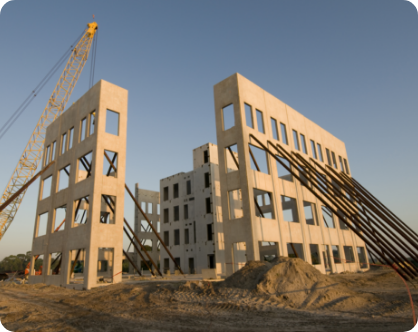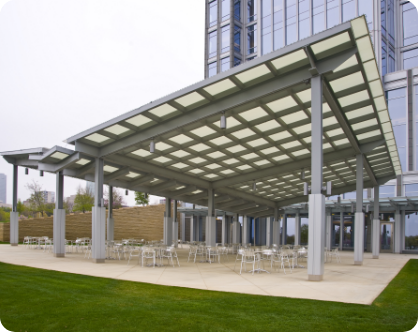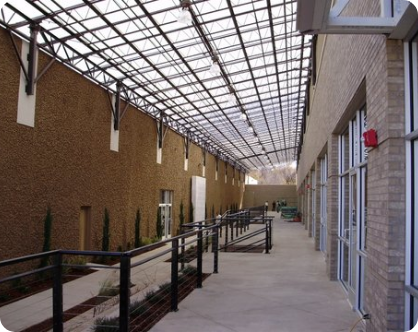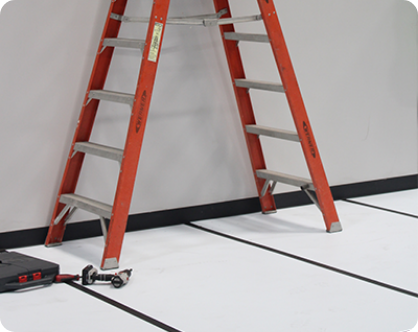The use of plastics in architecture and construction has grown considerably. It is consistently used as a replacement for wood and glass. Construction companies and architecture firms turn to plastics thanks to the material's many inherent qualities.
This article will review the uses of plastic in construction and architecture as well as plastic's advantages and the reasons for its popularity. We'll also look at which types of plastic are frequently used in construction and architectural applications.

The Advantages of Plastic Building Materials
Plastic building materials are a go-to choice in many architectural and construction projects because of their advantages over metal, glass and wood. Some of plastic's most outstanding benefits include:
- Durability — Plastic materials are corrosion-resistant. They provide a great strength-to-weight ratio and stand up to harsh environments. Plastic is also crack- and moisture-resistant.
- Recyclability — Material waste is becoming an increasing concern across industries, but plastic is relatively easy to reuse and recycle.
- Cost-effectiveness — Plastic is an economical choice compared to alternatives.
- Safety — Because plastics are lightweight and shatter-resistant, they can reduce jobsite injuries.
- Ease of installation — Their light weight also makes plastics easier to handle and install.
Purchase Plastic for Construction Applications From Regal Plastics
Regal Plastics is a leading supplier of plastic for construction applications. We're well-versed in the needs of the architecture and construction industries and can help you select the plastic best suited for your requirements.
Request a Quote Today

Common Plastic Building Materials
While architecture and construction projects rely on a wide range of plastic building materials, some choices are more common than others. Popular plastics in construction include:
- Acrylic — These sheets are lightweight and shatter-resistant. Designers and architects use decorative acrylic sheets to create innovative spaces.
- Polycarbonate — This material offers high impact strength, excellent clarity and outstanding thermal efficiency. Other characteristics of polycarbonate include toughness, stiffness and excellent dimensional stability.
- Polypropylene — Designed for high-use, high-abuse applications, polypropylene is moisture-, stain- and crack-resistant. It also offers high impact resistance.
What Is Plastic Used for in Construction?
Construction projects use plastic for a broad array of applications. It's frequently used in pre-construction tasks rather than structural applications. Professionals choose plastic for construction elements like:
- Temporary flooring — Its durability and resistance to corrosion, wear and impact make plastic an excellent choice for construction site flooring. Coroplast is a cost-effective solution to protect floors during construction and remodels.
- Temporary windows — Able to withstand harsh weather, plastic is often used for temporary glazing in construction projects. Polycarbonate is highly suitable for this application because of its clarity and impact resistance.
- Moisture barrier — Thanks to plastic's water-proofing capabilities, it's often used as a moisture barrier on construction sites.
- Reveal strips – HDPE reveal strips for tilt-up panels have become a popular choice. The material is flexible and does not absorb water, making the strips reusable, unlike wood.


What Is Plastic Used for in Architecture?
Plastic building materials also have a place in architectural projects. Architects prize plastic for its versatility and design flexibility. You'll often find plastic in features like:
- Skylights — Its impact resistance and clarity make plastic an excellent choice for skylights. Polycarbonate, which is available with a UV protective coating, is used for this application.
- Structural ceilings — Available in various colors and designs, plastic is frequently selected for structural ceiling panels. Plastic characteristics invaluable for this application include light weight, durability and cost-effectiveness compared to other materials.
- Roofing — Multiwall polycarbonate is a great solution for medium- to large-span pools, walkways and outdoor seating. It allows in natural light while lowering temps in the summer and retaining heat in the colder months.
- Bullet-resistant glazing — Bullet-resistant polycarbonate and acrylic offer excellent ballistic protection. The materials can maintain visibility and integrity even after repeated impacts.
Frequently Asked Questions About Plastics in Architecture and Construction
Regal Plastics is proud of its leading role as a producer of plastics in architecture and construction. Read on to learn more about these versatile materials.




